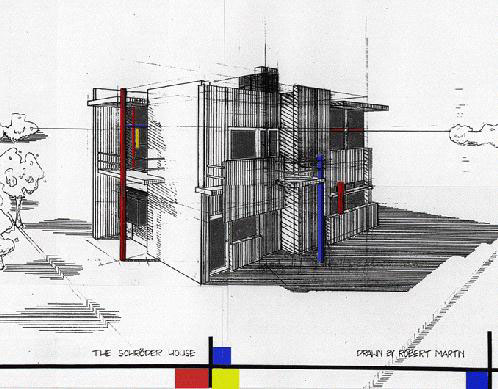The Rietveld Schroder House is a must know, and a must see, for anyone remotely interested in architecture. Located in Utrecht (fourth largest city in the Netherlands) and built by the Dutch architect Gerrit Rietveld for Mrs Truus Schroder-Schrader in 1924, this house is the best known example of De Stijl architecture, and arguably the only true De Stijl building.
Inside there is no static accumulation of rooms, but a dynamic, changeable open zone. The ground floor can still be termed traditional; ranged around a central staircase are kitchen and three sit/bedrooms. The living area upstairs, stated as being an attic to satisfy the fire regulations of the planning authorities, in fact forms a large open zone except for a separate toilet and a bathroom. Rietveld wanted to leave the upper level as was. Mrs Schroder, however, felt that as living space it should be usable in either form, open or subdivided. This was achieved with a system of sliding and revolving panels. When entirely partitioned in, the living level comprises three bedrooms, bathroom and living room.
In-between this and the open state is a wide variety of possible permutations, each providing its own spatial experience.
The facades are a collage of planes and lines whose components are purposely detached from, and seem to glide past, one another. This enabled the provision of several balconies. Like Rietveld's Red and Blue Chair, each component has its own form, position and colour. Colours were chosen as to strengthen the plasticity of the facades; surfaces in white and shades of grey, black window and door frames, and a number of linear elements in primary colours.
There is little distinction between interior and exterior space. The rectilinear lines and planes flow from outside to inside, with the same colour palette and surfaces. Even the windows are hinged so that can only open 90 degrees to the wall, preserving strict design standards about intersecting planes, and further blurring the delineation of inside and out.
Mrs. Schroder lived in this house until she passed away in 1985. Since then the house was restored by Bertus Mulder and now is a museum open for visits. Since the year 2000 it has been placed on the UNESCO list of world heritage sites.




















